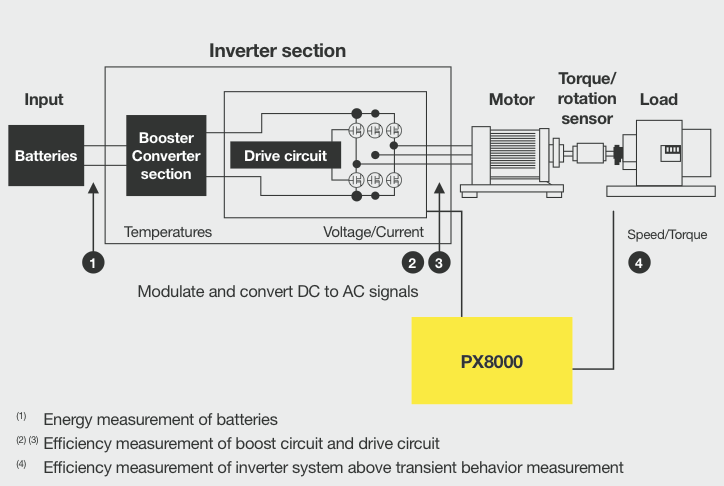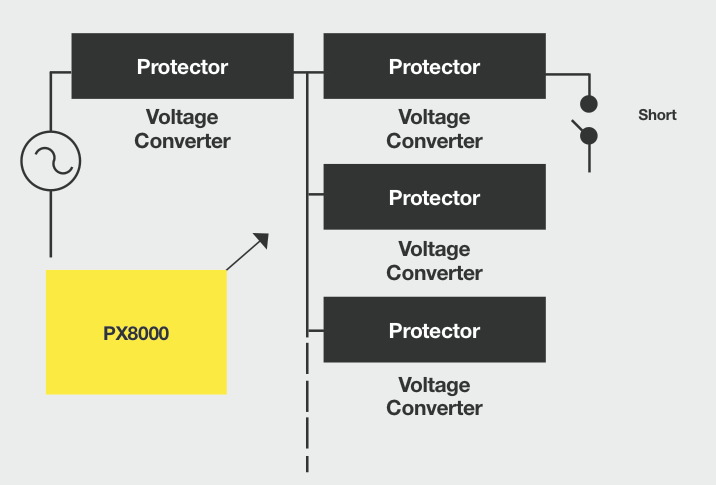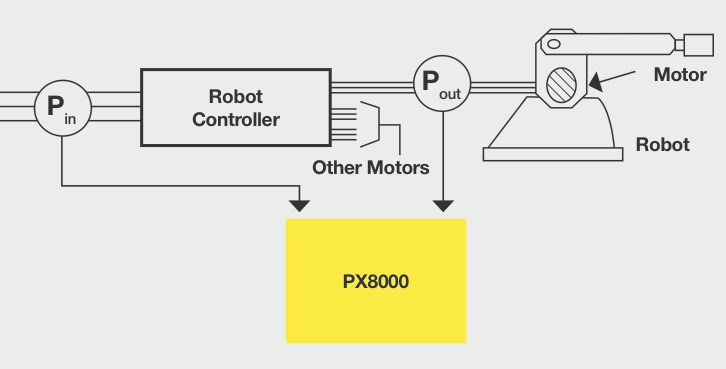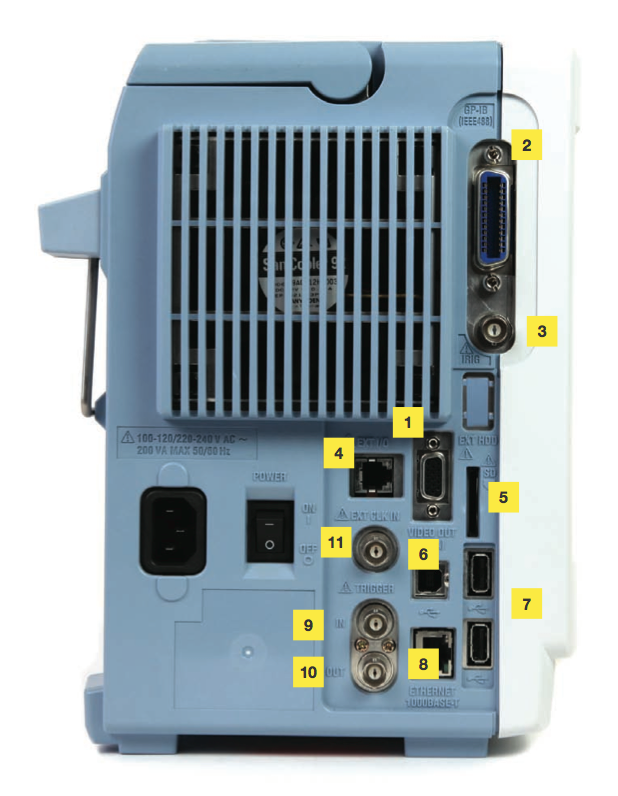Yokogawa PX8000 Precision Power Scope
Description
The PX8000 has a number of innovative features that support the crucial measurement and analysis of transient power profiles.
|
Simultaneous power calculation |
Provides simultaneous voltage and current multiplication to give real-time power sampling. |
|
Cycle-by-cycle power trend measurement |
Trend measurements between waveforms can be calculated by mathematical functions (up to four million points). |
|
Specific time-period measurementNew |
Supports the capture of power parameters over specific periods of time through the definition of start and stop "cursors". |
|
Specified time-period waveform measurement |
Supports the capture of waveform parameters over specific periods of time through the definition of start and stop "cursors". |
|
X-Y display and phase analysis |
Supports X-Y axis displays as standard. It can also display lissajous waveforms of input and output for phase analysis. |
|
Capturing sudden or irregular phenomena |
An always-active History function automatically records up to 1,000 historical waveforms. |
|
Long-period data capture and analysis |
An accompanying PC application called PowerViewerPlus can be used to capture waveform data for further analysis. |
|
FFT analysis |
Features arithmetical, time-shift, FFT and other computations that enable users to display waveforms with offsets and skew corrections. |
|
Simultaneous harmonic measurement |
Makes it possible to simultaneously measure the harmonic components of voltage and current waves as well as the harmonic distortion factor. |
|
Multifunction snapshots |
Up to 16 different waveforms- including voltage, current and power, can be displayed side-by-side, giving engineers instant snapshots of performance. |
|
Detailed transient analysis |
Supports the measurement of all power waveform parameters between precisely defined start and stop cursors. |
|
Trend calculation |
Built-in functions for the direct calculation of variables, such as root mean square (RMS) and mean power values, to enable the identification of cycle-by-cycle trends. |
|
De-skew compensation |
Automatic de-skewing function eliminates offsets between current and voltage signals that may be caused by sensor or input characteristics. |
|
Powered by isoPRO technology |
Offers industry-leading isolation performance at the highest speeds. Delivers the performance needed to develop high-efficiency inverters that operate at high voltages, large currents, and high frequency. |
Specifications & Detail 
The PX8000 is an immensely versatile instrument, unlocking precision power measurement capabilities for researchers working on everything from renewable power to advanced robotics.
Inverter and motor testing
Electric and hybrid vehicles have many electrical and mechanical components, and overall performance evaluation requires measuring the efficiency of both. The PX8000's flexibility, accuracy and wide bandwidth make it ideal for drawing together the range of power readings needed to optimize the efficiency of boost circuits and inverters- two key elements in overall electric vehicle performance.
|
Wide bandwidth |
With a 12-bit resolution, 100 MS/s sampling, and 20MH bandwidth, the PX8000 can be used for accurate measurement of inverter pulse shaped, which can then be used to fine-tune inverter efficiency. |
|
Transient measurement by cycle-by-cycle trend |
The ability to analyze cycle-by-cycle trends makes it ideal for the measurement of transient effects. When the load changes rapidly, engineers can gain insights that will enable them to improve the control of the inverter. |
|
Harmonic and FFT analysis |
With both harmonic and FFT measurement capabilities, the PX8000 can measure fundamental waveforms from 20Hz to 6.4kHz. This is particularly useful for analyzing higher harmonic component and causes of noise in electromechanical systems. |
|
Offset cancels by individual NULL function |
A common problem when testing inverter motors is the presence of ambient noise that can mean test values are nonzero even before testing begins. The PX8000's offset capabilities mean such effects can be nullified and specific inputs can be isolated for testing and analysis. |

Reactor loss measurement of inverter boost circuits
A reactor is used to filter out noise and boost voltage levels prior to the use of an inverter. It consists of an electromagnetic material core and a coil. A main focus for electrical engineers is to reduce power loss across the total inverter system, and reactor performance is of particular interest. There are two potential evaluation methods: direct loss measurement of the reactor and iron loss measurement. The PX8000 supports either methodology because it can accommodate both high frequency measurement and low-power-factor conditions.
|
Low-power-factor measurement |
Higher sampling rates and broad bandwidth make the PX8000 particularly useful for testing devices, such as transformers and reactors that have lower power factors. It is particularly important to measure the precise power consumption of such devices at high frequency. |
|
De-skew functionality |
To analyze power consumption in low-power-factor devices it is particularly important to minimize any time differences between voltage and current caused by sensor input characteristics. The PX8000 provides precise de-skew adjustment to compensate for this time difference. |
|
Core loss measurement under high frequency |
Analyzing reactor core loss is an example of how the PX8000's user-defined functions can be utilized to provide an instant analysis of system performance. In the example below, core loss is calculated based on primary coil current and secondary coil voltage, while magnetic flux density (B) and magnetic field (H) are calculated by factoring in input frequency, cross-sectional area and other parameters. All values can be displayed directly by the PX8000. |

Wireless charger efficiency measurement
The development of wireless charging technology for mobile devices like smartphones and tablet devices is a focus for research. Automotive manufacturers are looking into the possibility of charging electric vehicles wirelessly. Wireless charging depends on two electromagnetic coils being configured to support particular frequency profiles. Efficient power transfer and the prevention of power loss are naturally particularly important. The PX8000 is ideally suited for measuring such systems because of its ability to operate at high frequencies and low power factors.
|
Wireless charger efficiency evaluation |
To evaluate the efficiency of wireless transfer, at least three power measurement elements are required. The PX8000, with its four input channels, can analyze the performance of the whole system simultaneously. |
|
Low-power-factor device measurement |
Higher sampling rates and broad bandwidth make it ideally suited for wireless power transfer systems. The PX8000 supports 12-bit resolution, sample rates of up to 100MS/s and a 20MHz bandwidth. The PX8000 supports the measurement of low-power-factor systems operating at very high frequencies.
|
|
De-skew functionality |
Because the PX8000 provides a de-skew function, differences between voltage and current that are introduced by sensor and input characteristics can be compensated for and eliminated from the analysis of low-power-factor systems.
|

Power distribution
Power distribution systems have to maintain constant voltage and constant power during load switching or in the case of a short circuit. Distribution protectors or circuit breakers for three-phase electrical systems must therefore be tested at transient voltage and power levels. The PX8000 can capture fluctuation voltage and current waveform, calculate power parameters (including voltage and current values), determine an average over a specified period and display all values.
|
Simultaneous three-phase data capture |
To evaluate three-phase electrical systems, at least three power measurement inputs are required. The PX8000 has up to four inputs and enables the simultaneous capture and display of voltage and current across all three phases. |
|
Specific time-period measurement |
For a true evaluation of distribution protection, it is necessary to measure a full cycle of voltage current and power values half a cycle after the recovery from a short circuit. The PX8000 can easily be set up to focus on such a specific period. |
|
Harmonic and FFT analysis |
The PX8000 has capabilities for both harmonic measurement and FFT for frequency analysis. The harmonic function can measure fundamental frequencies from 20Hz to 6.4kHz, and FFT has 1k to 100k points calculation across two channels. Such measurements are vital for identifying harmonic currents and identifying sources of noises. |

Transient responses of industrial robots
To evaluate motor-driven robots, power consumption of all motors and controllers are measured throughout all operational speeds and action patterns. Design engineers need to measure inrush voltage, current and power over the pattern of repeated actions. Efficiency is calculated by comparing mechanical output with input power. During actual operating conditions, the time to accelerate and decelerate such motors can range from several hundred milliseconds to several seconds. As a PWM-driven motor rotates from the reset position to the top speed, the drive frequency from the rest position to the top speed, the drive frequency changes from DC to several hundred Hz. The PX8000 gives design engineers insight into power consumption and efficiency throughout a robot's operational performance.
|
Specific time-period analysis |
Supports the measurement of waveform data between specific Start/Stop cursors. Combined with its multi-channel capabilities and its Long memory and History functions, this makes the PX8000 particularly useful in rating a robot's operational power consumption. |
|
Efficiency measurement of boosters, inverters and motors |
A single PX8000 unit can measure both the input/output power of inverters and the mechanical output of a motor. By installing three power units and one AUX module, the PX8000 can be configured to provide an instantaneous measure of component efficiency.
|
|
Transient measurement by trend computation |
With its instantaneous power calculations, the PX8000 is ideal for evaluation and optimizing transient effects. Its cycle-by-cycle trend analysis provides further insights into this crucial area of robotics engineering.
|
|
Longer time-period measurement |
To analyze some robotic operations, it may be necessary to perform cycle-by-cycle trend analysis over a long period of time. The PowerViewerPlus software extends this mathematical capability to enable deep insights to be obtained from the data. |

Long phenomena capture
The large internal memory of up to 100M Points enable long term measurements to be made at high and appropriate sample rates.

|
1 |
Video Out |
Video signal output for enhanced display on analog RGB displays |
|
2 |
GP-IB |
General purpose interface bus |
|
3 |
IRIG |
Synchronize multiple instruments via an external time source (optional) |
|
4 |
EXT I/O |
The PX8000 can be used to send a GO/NO-GO signal based on set conditions; equally external signals can be used to trigger measurement and analysis |
|
5 |
SD card slot |
SD- and SDHC-compliant |
|
6 |
USB-PC |
Enables control from a PC |
|
7 |
USB |
For connection to a range of peripherals including storage, keyboard and mouse |
|
8 |
Ethernet |
1000BASE-T comes as standard |
|
9 |
TRIGGER IN |
External trigger input |
|
10 |
TRIGGER OUT |
External trigger output |
|
11 |
EXT CLK IN |
Sampling can be timed to an external signal (up to 9.5 MHz) |
Data Sheet & Downloads 
|
|